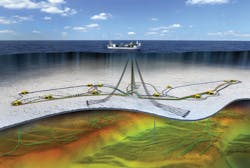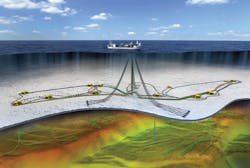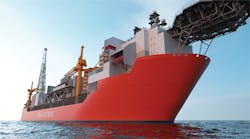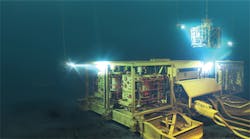Johan Castberg project re-engineered for harsh Barents Sea environment
Innovations in FPSO, subsea production system
Jeremy Beckman,Editor, Europe
Late lastyear, Equinor and its partners finally sanctioned the Johan Castberg project in the Barents Sea after halving the costs of the development, compared with earlier proposals. Aker Solutions played a major role in this process, through its suggestions and subsequent designs for the harsh-environment FPSO and the subsea production system, both of which will introduce novel technical concepts to the Norwegian continental shelf (NCS).
Johan Castberg comprises the Skrugard, Havis, and Drivis oil discoveries in 360-390 m (1,181-1,279 ft) water depth in license PL 532, 100 km (62 mi) north of the Snøhvit field and 150 km (93 mi) from the Goliat field FPSO. Equinor estimates recoverable resources in the range of 450-650 MMbbl. The 295-m (968-ft) long, 55-m (180-ft) wide FPSO, which will be Norway’s largest to date, will be stationed 240 km (149 mi) offshore Hammerfest. Sembcorp Marine in Singapore is building the hull and living quarters, while Kvaerner has overall responsibility for construction and installation of the topsides.
Johan Castberg field schematic. (Courtesy Equinor)
Aker Solutions is responsible for detailed design of the topsides and providing engineering, procurement, and management assistance. It is also responsible for the design of the living quarters, under a sub-contract from Sembcorp Marine, and for engineering and supplying the entire subsea production system. This will comprise 30 wells with VXT vertical subsea trees – a new design developed in collaboration with Equinor – associated wellheads and control systems, 10 templates and manifolds, two satellite structures and associated tooling. In addition, two of the company’s yards in Norway are building the FPSO’s flare boom and the water and chemical injection modules.
Investment delays
According to Aker Solutions’ Johan Castberg Project Director Nils Olav Solheim, the company was first invited to tender for the front-end engineering design (FEED) in early 2013 and won the contract that summer. The initial studies were based on a semisubmersible platform exporting oil through a subsea pipeline to a new onshore terminal at Veidnes in northern Norway. In mid-2013, however, the investment decision was delayed due to uncertainties over the tax framework and the reserves range. Statoil, as Equinor was then known, decided to drill five wells on other prospects in the area, in the hope of proving further reserves to strengthen the development’s business case – but results were largely disappointing.
By that point, the company had extended Aker Solutions’ remit to parallel studies of a semisubmersible and an FPSO offloading to shuttle tankers. However, in summer 2014, when the program had been running for around a year, the oil price started to slide and alarm bells began ringing about the projected costs of NOK100 billion ($12.2 billion), with a minimum breakeven of more than $70/bbl.
The Johan Castberg FPSO. (Courtesy Aker Solutions)
In March the following year, the partners decided a further delay was called for on selection of the concept until the second half of 2016, with a final investment decision pushed back until late 2017. At that point, the estimated cost of a newbuild platform was around $4 billion. “Equinor told us they would have to go for a cheaper alternative,” Solheim said, “and requested a 15% cost saving on the 2014 figure. We thought that would be possible, with Equinor’s help in questioning some of the functional requirements.
“For the FPSO, Equinor had settled on an oil storage capacity of 1.3 MMbbl in the hull. We asked whether we could challenge this – was such a volume really needed, or could we go down? So, we reduced the capacity to 1 MMbbl, also questioning the scale of the logistics and the shuttle tanker arrangements. But the partners decided they still wanted slightly more storage, so we compromised by recommending a switch to more space-efficient electrical/hydraulic pumps in order to increase the oil storage capacity in the hull. That was one of various ideas we came up with for reducing the overall cost.”
This will be Norway’s most northerly Arctic development project to date and as with the Goliat FPSO, there will be a need for extensive winterization measures to protect the crew and the topsides equipment. Aker Solutions designed the FPSO SeaRose that operates for Husky Energy on the White Rose field offshore Newfoundland. “We have relatively good connections via people from that team,” Solheim said, “and have drawn to an extent on their experiences for Johan Castberg. However, the climate offshore eastern Canada is closer to the Norwegian Sea than the Barents Sea – besides that, they have icebergs to contend with.
“The main difference in the Barents Sea is the prevalence of polar lows, with a combination of snow, sea spray icing, sub-cooled rain, and fog. We have taken all these factors into account, with an emphasis on heating where needed of exposed surfaces and equipment with electrical cable heating, water heating for the helideck, and re-use of waste heat from the turbines.”
The Johan Castberg FPSO will be the first offshore application of Siemens’ SGT-750 gas turbine – a 41-MW version will drive a compress train that will re-inject the field’s gas to pressurize the oil reservoir. Siemens will also provide a waste heat recovery unit that will capture heat from the gas turbine’s exhaust for distribution as heated liquid to prevent ice build-up on various parts of the superstructure, or to heat the HVAC plant or incoming crude from the wells. Further waste heat will be recycled from the GE power generator on the aft side of the ship.
“We have also done studies on the impact of snow accumulation based on wind simulations,” Solheim said. “If you do the construction in a certain way, it can lead to large accumulations of snow, similar to alpine cottages in winter. We have performed simulations for the FPSO’s doors, walkways, lifeboats, and escape areas in order to avoid this happening.”
SBM Offshore has designed the turret mooring system, under construction at Drydocks World in Dubai, which will accommodate 10 risers with a total capacity for 21 risers. Aker Solutions has had partial involvement in the mooring system FEED studies, making recommendations concerning the impact of snow and cold temperatures, and the company retains overall responsibility for the safe interface of the completed turret with the hull and the various connection points. The hull, under construction in Singapore, will have structural reinforcements for possible sea ice, “although we have tried to slim these down as much as possible based on available environmental design data during the FEED,” Solheim said.
Winter hazards
Aker Solutions has seconded staff to Singapore to ensure the various interfaces are following recommendations from the FEED in the detailed design, and Equinor has hired some of the company’s individuals to undertake follow-up measures, such as maintaining stability calculations.
The topsides modules, which are under construction at yards in Egersund, Sandnessjoen, Stord and Verdal, are in general relatively small compared to fixed platform topsides, Solheim added, with a typical weight range of 2-3,000 metric tons (2,204-3,307 tons), and therefore well within the range of mainstream heavy-lift vessels. Kvaerner is building a new deepwater quay in western Norway that will accommodate the Johan Castberg hull for the topsides installation/integration campaign.
“The design of the modules is not very different from those on a normal harsh-environment FPSO,” Solheim said. “What we have had to do is to perform verifications to ensure the winterization measures protect the working area on the deck for maintenance-intensive activities. This could mean removing snow that might accumulate in certain areas, and taking precautions against falling ice. Flare stacks in particular are prone to falling ice as elevated structures following changes in temperature: in this case, the flare is on the back of the weathervaning ship, i.e. always downwind, which means accumulated ice will mostly fall into the sea. But there could be more of an issue with ice falling off the other high structures such as exhaust stacks – if that becomes an issue, we could put up safety nets, similar to the principle applied in mountain areas to protect against falling rocks.”
Although the FPSO has been downsized where possible to minimize the cost, space has been made available on the deck to accommodate future tiebacks in the event of further discoveries in the area. “And there is even the possibility to electrify the FPSO in the future should associated infrastructure be developed,” Solheim added.
Gas will be injected from the start of production in late 2022, with flaring not allowed. One of the first development wells to be drilled will be a gas injector, Solheim added: the initial design rate will be around 8 MMcm/d, building slowly from day one, with the speed of the increase dependent on the output of the production wells.
Aker Solutions’ detailed design responsibilities, managed from its offices in Norway and India, last technically until tow-out of the FPSO to the field in 2022. But the company expects to complete the detailed design for the drawings for the various yards in the fall of 2019, followed by a long tail-end period of answering any construction queries the yards might have. “We will support these, but at a much lower manpower level,” Solheim said. “We also have an overall responsibility to ensure that the entire production system will work, from wellheads to the offloading system.
“This will be a standard offloading arrangement for an FPSO in northern Europe. However, there have been some discussions concerning instances of shuttle tankers being too close to the FPSO during offload operations, so we have investigated the possibility of longer hoses for Johan Castberg, with the vessels not in the conventional tandem configuration, but in a safer ‘off track’ position in case the shuttle tanker loses power.”
VXT benefits
Manufacturing of the various components for the subsea production system (SPS) is being spread among Aker Solutions’ plants in Norway, the UK, Brazil, and Malaysia, supported by suppliers in China, across Europe and along much of the Norwegian coastline up to Hammerfest. First shipments are due out next spring, with the final delivery set to be completed in the first half of 2023, a few months after first oil from Johan Castberg.
Subsea vertical tree. (Courtesy Aker Solutions)
In the company’s view, vertical subsea trees are rapidly becoming a standard option for projects on the NCS as operators in the region pursue further cuts in field development costs and rig time. Equinor collaborated with Aker Solutions on the design of the new VXT systems for this project and has committed to further consignments for Phase III of the Troll field development in the North Sea and the Askeladd subsea tieback in the Barents Sea. More VXTs are on order for Aker BP’s AErfugl tieback to the Skarv FPSO in the Norwegian Sea.
At present there are two versions:
• 7x5 VXT on WH – 7-in. vertical bore with 5-in. outlet
• 7x7 VXT on WH – 7-in. vertical bore with 7-in. outlet
According to Aker Solutions Senior Product Specialist Lars Lundheim, both are equipped with flow modules that define the duty of the tree (i.e. producer, gas injector, water injector). “This also means that there is one common tree for all duties,” he explained, “whereas the flow module is the configurable unit.
“There are many advantages with the 7-in. VXT. It comprises our latest and most reliable tree technology. It has been developed from a minimum cost of ownership point of view as a standard tree with a low installation size and weight (the same applies to the larger 7x7 version), installable by light vessels. This also drives down the size of the rest of the SPS. As such, it has been not only a subsea trees exercise, but a journey where all related areas of the SPS have been optimized to ensure that the total cost of ownership goes down. In this case, we are talking about cost for operators during the field’s full lifetime, not solely the initial investment cost.
“The main manufacturing of the various constituent parts is very similar to how we have produced our previous systems. Manufacturing and testing can be performed at all the company’s relevant sites. A significant part of the development of the components that make up the new tree systems has been to simplify and ensure optimized manufacture and test processes.”
Conceptual studies for the new VXT system were under way before Johan Castberg was even on the drawing board. However, this project was the major catalyst for the development, the first milestone being a full-scale qualification of the 7-in. vertical subsea tree which started in 2013. “This involved a combination of qualifying the underlying technologies needed for the tree,” Lundheim said, “and a continuous development of the surrounding technologies, fabrication methods, installation methods, and seeking ways of reducing the maintenance cost.”
Sigurd Loftheim Dale, Specialist System Engineer at Aker Solutions, added: “The success of the qualification can largely be attributed to great collaboration between Aker Solutions and Equinor on many levels, which included detailed feedback on technology proposals, installation and maintenance concepts. Equinor set targets for the cost of the equipment, installation ‘friendliness,’ and the level of maintenance. And these targets were set not only with Johan Castberg in mind, but as an enabler for a range of future field developments.”
To comply with the various requests, Aker Solutions employed a series of approaches, he continued, “many of which were based on value engineering and lean principles. One of the most powerful tools was that we adopted a business case approach to challenge requirements where we saw these as a block to good system solutions. But this was always done with the highest quality, safety and reliability in mind as compromises on these areas would never be cost-efficient. As a result, there has also been development of templates, manifolds and connections systems and Aker Solutions’ new Vectus control system.”
According to Lundheim, “the 7x5 vertical subsea tree is the company’s lightest and best standardized multi-application tree, with a dry weight of less than 35 metric tons [38.5 tons]. The 7x7 version is small both in size and weight, considering that it contains a full 7-in. through bore outlet with 7-in. metering equipment and choke options with flow coefficients of up to 1,200. These results were achieved through a series of improvements to packaging and other measures, continuously optimizing the design towards the targeted cost, weight, and size.
“Aker Solutions undertook the main development work internally, but with regular design reviews, failure mode analysis and so on with members of Equinor’s subsea team. And when we challenged certain requirements, this too was handled directly with Equinor’s specialists in order to avoid time-consuming and bureaucratic processes. All the components had to be qualified to Technology Readiness Level 4 (TRL4) or TRL5, depending on functionality.”
The 30 wells scheduled for Johan Castberg are slightly lower than the total envisaged in the original plans in 2013, Loftheim Dale said. “Drilling will now be performed using one rig instead of several, which was the first idea. This has been enabled in part by reducing the time spent on each well by the drilling rig. In terms of the local environment and its possible impact on the drilling campaign, the main issues are short weather windows and challenging logistics. We are responding by doing more work and preparing more equipment locally in northern Norway.
“As for the various connections between the SPS and the FPSO, there are numerous technological innovations. Highlights include our Subsea Communication Gateway with standardized interface to the FPSO control system (MDIS) and the power and communication solution (DC/FO). This is also the first time we are demonstrating an integrated delivery model with our own FPSO contract, as well as drawing on our subsea alliance with ABB.”
Another key feature of the VXT development has been challenging standard maintenance concepts for subsea trees to help meet cost-saving targets, Lundheim said. “The results in this area are as impressive as what we have achieved on the tree and system side. Some of the innovations that have enabled these results include condition-based maintenance, re-use and standardization of tools; optimization of operations; and condition monitoring.”
Lundheim added that Johan Castberg and AErfugl will employ the same design of 7x5 VXTs, while Askeladd and Troll Phase III will feature the same 7x7 versions. There will, however, be field-specific differences in terms of the flow modules and connecting equipment. •



